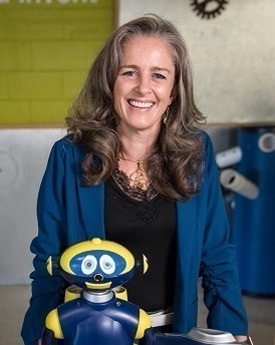Beyond bulky VR headsets: Voice recognition, eye tracking, and natural gestures in the era of the metaverse and the “Medi-verse”
 Imagine you have moved to a new city and bought a condo advertised as “metaverse enabled.” Upon closing, along with the physical keys to your condo, you receive a unique cryptographic key to the community. You move into your neighborhood both physically and digitally. With the crypto key, you link your own personal metaverse profile to the condo. This merges your personal metaverse, including a digital catalog of all the objects in your home, to a digital map of the new space integrating all the sensors and devices that control the objects through the metaverse.
Imagine you have moved to a new city and bought a condo advertised as “metaverse enabled.” Upon closing, along with the physical keys to your condo, you receive a unique cryptographic key to the community. You move into your neighborhood both physically and digitally. With the crypto key, you link your own personal metaverse profile to the condo. This merges your personal metaverse, including a digital catalog of all the objects in your home, to a digital map of the new space integrating all the sensors and devices that control the objects through the metaverse.
As you move from your bedroom to the kitchen, the lights switch on, and the room temperature adjusts. In the kitchen, you tell the stove to turn on and a graphical display appears in front of you as you turn your gaze toward the refrigerator. You reach out your hand and select the egg icon, which reveals that you have three eggs left. You swipe up with your hand and the order goes out for more eggs.
As you prepare breakfast, you gesture again, and in another moment your mother’s face appears in front of you. “Mom, do you want to join me for breakfast?” “Sure,” she responds as she turns down your stove so your eggs don’t burn! You gather your eggs and bacon and sit down at the table, which has moved out from a recess in the wall in anticipation of your approach. You sit down, your mother’s hologram appears across from you with her breakfast, and the two of you begin to discuss your day.
Later that evening as you walk around the neighborhood guided by your AR display, you’re prompted with information tagged to houses throughout the neighborhood. One that catches your eye says, “Book club meeting at 6:30 p.m. tomorrow at my house—digital only this week, meet in the community metaverse lounge. New members welcome!” You’ll fit right in!
Ready to move into this condo? What I’m really describing is a form of spatial computing—technology that seamlessly integrates the physical and virtual world. I wrote about spatial computing in a Scientific American article in 2020, and it’s one of the building blocks of the metaverse, the vast network of physical and virtual networks primed to redefine the way we live and work in the not-so-distant future.
You may have glimpsed the metaverse already if you’ve watched the movie Ready Player One or played Minecraft or Fortnite. Massively multiplayer online games like Fortnite have been around for over two decades, as have online worlds like Second Life. Around the time I started AnthroTronix in 1999, Jacki Morie, a virtual reality pioneer, helped establish the University of Southern California’s Institute for Creative Technologies, an army-funded research lab finding connections between entertainment and military needs.
She started the Coming Home project in 2009, creating a center in Second Life where veterans and soldiers could find stress relief and rehabilitation activities. Kindred spirits in the quest to use technology to create meaningful experiences that enable ability and enrich people’s lives, we began a collaboration. We connected our digital glove technology to Second Life, enabling veterans using wheelchairs to rock-climb, and our teams jointly invented a “scent necklace” that released computer-controlled scents to make virtual reality worlds more immersive.
We don’t really know the potential of the metaverse, or whether it will be completely virtual or a mix of physical and digital. As we leverage the internet, advances in virtual and augmented reality technologies, and spatial computing, there will likely be multiple metaverses, including a potential “Medi-verse” that focuses on healthcare delivery. But whether you enter a consumer-oriented gaming metaverse or an immersive work one, one thing that seems unlikely is us continuing to interact with the digital world through desktop computers, smartphones, and bulky headsets. More likely, we will interact with the digital world through voice recognition, eye tracking, and natural gestures like in the scenario above.
My vision of the metaverse is that we will be able to physically go about our daily activities while interacting in real time with friends and colleagues around the world. I want to go into a business meeting and sit around a table with colleagues from different countries without fighting with video conferencing displays. I want to go to the gym and work out with my friends in Paris and San Francisco.
There is a much-used quote attributed to many, including Abraham Lincoln: “The best way to predict the future is to create it.” We have the tools to create the metaverse. What we do with them will be up to us.
 – Dr. Corinna (Cori) Lathan is a technology entrepreneur who has developed robots for kids with disabilities, virtual reality technology for the space station, and wearable sensors for training surgeons and soldiers. Above is an adapted excerpt from her new book, Inventing the Future: Stories from a Techno-Optimist (Lioncrest Publishing; 2022), which explores the many possibilities of tomorrow through Cori’s twenty-year journey inventing at the edge of technology and human performance.
– Dr. Corinna (Cori) Lathan is a technology entrepreneur who has developed robots for kids with disabilities, virtual reality technology for the space station, and wearable sensors for training surgeons and soldiers. Above is an adapted excerpt from her new book, Inventing the Future: Stories from a Techno-Optimist (Lioncrest Publishing; 2022), which explores the many possibilities of tomorrow through Cori’s twenty-year journey inventing at the edge of technology and human performance.


